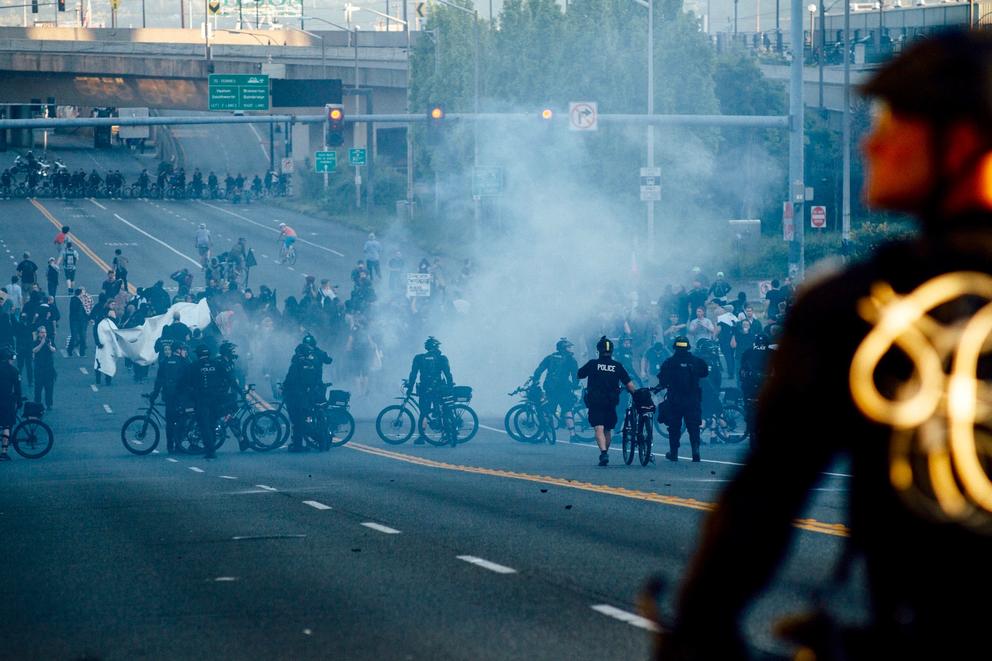The Seattle Police Department has limited its use of force to acceptable levels, says the monitor overseeing the police reform agreement between Seattle and the Department of Justice.
Praising the police department, the court-appointed monitor pointed particularly to reductions in uses of the most severe force, where people could suffer serious or fatal injuries.
However, the report also suggested that the police haven’t yet rooted out all bias in how they operate.
The finding from the monitor, Merrick J. Bobb, released Thursday, marks a milestone in the city's efforts to improve relations between police and local communities, particularly those from historically disadvantaged populations.
“The significance and importance of this finding cannot be understated, as this report makes clear,” reads the assessment. “It represents a singular and foundational milestone on SPD’s road to full and effective compliance — and represents Seattle crystallizing into a model of policing for the 21st century.”
Reducing excessive force was one of the chief obligations for the Seattle Police Department to meet since Seattle was sued by the Justice Department and the two sides signed a settlement agreement (or consent decree) in 2012.
SPD's tendency toward force has been an issue in the department for years, shown most vividly in 2010 footage of Officer Ian Birk shooting Native American woodcarver John T. Williams in the back. And when force was used, reporting was spotty and accountability often weak. For Bobb to say this box has been checked suggests the city is approaching final completion of its agreement, a thorn in the side of two separate mayors. Bobb has suggested that Seattle could be out from under the consent decree within a year; this assessment would seem to make that more likely.
The pronouncement by the monitor is based on data that shows use-of-force has dropped precipitously since 2014. And when force is used, said the report, it is almost always consistent with SPD policy.
The findings also show that crime and officer injury have decreased over the same period, throwing a wrench into suggestions by Attorney General Jeff Sessions that federally driven reform creates ineffective police forces reluctant to enforce the law — the so-called “Ferguson effect.”
The most significant drop in the use of force is among so-called Type II and III encounters: incidents that range from hobbling physical harm to permanent damage to death. Compared to 2011, when the DOJ released its investigation, these incidents are down 60 percent, says the report.
Officer involved shootings are also down 39 percent, as is use of batons or tasers.
Lower level uses of force rose rose slightly between 2014 and 2015. With the decrease in upper-level incidents, low-level reports now make a larger portion of the department’s overall use of force.
"Changing culture is slow-going and hard work, but our city’s efforts are bearing real, positive results," said Councilmember Tim Burgess in a statement. "The officers who are on the street every day deserve all the credit.”
"This report demonstrates that agreements between local and federal governments enable a productive process for police reform without sacrificing public or officer safety," said Councilmember Lorena Gonzalez, also in a statement. "Seattle officers, SPD leadership and community have put in the hard work it takes to create a world where people feel safe in their homes, at their places of work and on our streets.”
Since Seattle entered into the agreement with the DOJ, enormous emphasis has been placed on de-escalation and crisis intervention training to avoid repeats of the Williams incident. The monitor and other involved parties credited these new trainings and procedures for the reduction in force. "The findings demonstrate that rigorous policies are in place, high-quality training and supervision have been implemented, proper reporting and investigation is happening, and appropriate levels of force are being used," said Annette Hayes, the U.S. Attorney for Western Washington, in a statement.
The report does not show a perfect department, to be sure. Just 13 percent of officers accounted for 40 percent of use of force reporting, including one officer with 34 incidents over two years and another with 49. While the report does not draw any direct conclusions about what this may mean, it could suggest that not all officers have gotten the memo yet.
Further, there continues to be some racial disparity in the numbers, with non-white people still more likely to be subject to force. On top of that, officers are more likely to point a gun at non-white residents than white.
This report acknowledges, however, that while compliance with use of force requirements is a big step, questions of bias have not been resolved. “Although this report finds compliance on a core area of the Consent Decree [use of force], the Monitoring Team continues its work on its other major pillar: discriminatory policing." The report contains no suggestion about whether the department is close to meeting this requirement.
In a political sense, the timing of the new report couldn’t be better for Seattle: Just days ago, Attorney General Jeff Sessions called for a review of reform agreements between the federal government and local police departments, like the one in Seattle. "This is directly attributable to our reform effort under the federal monitoring," City Attorney Pete Holmes told Crosscut Thursday. "It's been an incredible experience for Seattle and it's unfortunate this administration can't see the value for other cities."
Earlier this week, Mayor Ed Murray responded to Sessions saying he would be prepared to fight in court if Sessions tried to derail the reform agreement here, although that wasn't regarded as likely even before the monitor's findings of exemplary progress by Seattle police.



